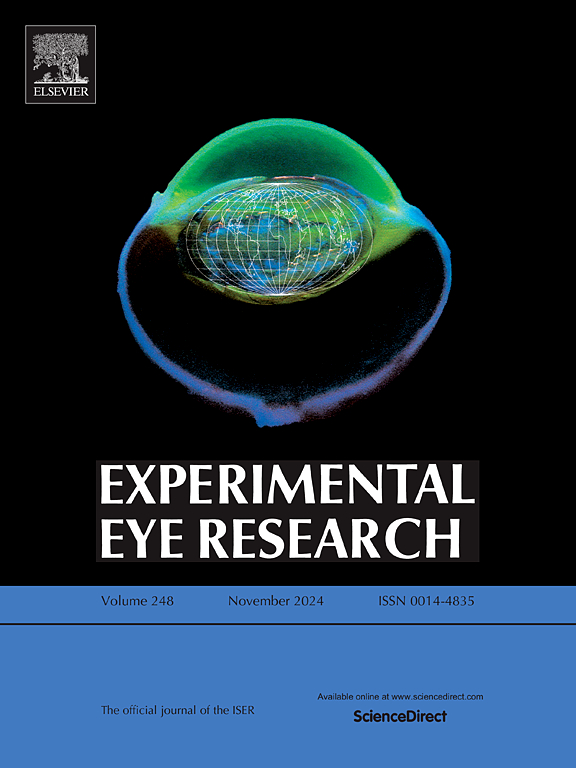黄芩苷通过抑制PERK/TXNIP/NLRP3通路改善糖尿病干眼模型的炎症反应。
IF 3
2区 医学
Q1 OPHTHALMOLOGY
引用次数: 0
摘要
糖尿病是干眼症的重要危险因素。干眼症可引起角膜上皮细胞的结构和功能紊乱,严重影响糖尿病患者的视觉质量。黄芩苷(Baicalin, BA)是黄芩的主要成分之一,具有抗炎和抗氧化的作用。然而,BA对糖尿病性干眼症患者是否有治疗作用及其机制尚不清楚。本文探讨黄芩苷在糖尿病性干眼症中的作用机制。在细胞中,我们使用高糖刺激的人角膜上皮细胞(HCE-T)进行建模。不同葡萄糖浓度下,通路相关蛋白p-PERK、NLRP3、TXNIP和IL-1β的表达存在差异,以25 mmol/L葡萄糖浓度下相关蛋白的表达量最高。BA对高糖诱导的hce - t细胞损伤和凋亡具有保护作用。此外,BA抑制PERK/TXNIP/NLRP3轴,从而减弱HCT-T细胞的炎症反应,但这种作用被PERK激动剂CCT020312逆转。我们采用C57BL/6小鼠腹腔注射链脲佐菌素(STZ)建立动物模型。BA抑制PERK/TXNIP/NLRP3通路,改善糖尿病干眼模型小鼠的角膜炎症。此外,BA增加了糖尿病干眼模型小鼠泪液分泌,降低了角膜荧光评分。因此,我们的研究证明了BA在缓解糖尿病性干眼中的重要价值,为糖尿病性干眼的发展提供了新的见解。本文章由计算机程序翻译,如有差异,请以英文原文为准。
Baicalin ameliorates inflammation response in diabetic dry eye models through the inhibition of the PERK/TXNIP/NLRP3 pathway
Diabetes mellitus is an important risk factor for dry eye. Dry eye may cause structural and functional disorders in corneal epithelial cells, seriously affecting the visual quality of diabetic patients. Baicalin (BA), a constituent of Scutellariae baicalensis, has anti-inflammatory and antioxidant properties. However, whether BA exerts a therapeutic effect on patients with diabetic dry eye and the underlying mechanism are unclear. Here, we explored the underlying mechanism of baicalin in diabetic dry eye. In cells, we used high glucose-stimulated human corneal epithelial (HCE-T) cells for modeling. There were differences in the expression of the pathway-related proteins p-PERK, NLRP3, TXNIP, and IL-1β under different glucose concentrations, and the highest expression of relevant proteins was observed with 25 mmol/L glucose. BA protected against high glucose-induced HCE-T-cell injury and apoptosis. In addition, BA inhibited the PERK/TXNIP/NLRP3 axis and thus attenuated the inflammatory response of HCT-T cells, but the effect that was reversed by the PERK agonist CCT020312. We used C57BL/6 mice injected intraperitoneally with streptozotocin (STZ) to establish the animal model. BA suppressed the PERK/TXNIP/NLRP3 pathway and ameliorated corneal inflammation in diabetic dry eye model mice. Moreover, BA increased tear secretion and decreased corneal fluorescence scores in diabetic dry eye model mice. Thus, our study demonstrates the important value of BA in alleviating diabetic dry eye and provides new insights into the development of diabetic dry eye.
求助全文
通过发布文献求助,成功后即可免费获取论文全文。
去求助
来源期刊

Experimental eye research
医学-眼科学
CiteScore
6.80
自引率
5.90%
发文量
323
审稿时长
66 days
期刊介绍:
The primary goal of Experimental Eye Research is to publish original research papers on all aspects of experimental biology of the eye and ocular tissues that seek to define the mechanisms of normal function and/or disease. Studies of ocular tissues that encompass the disciplines of cell biology, developmental biology, genetics, molecular biology, physiology, biochemistry, biophysics, immunology or microbiology are most welcomed. Manuscripts that are purely clinical or in a surgical area of ophthalmology are not appropriate for submission to Experimental Eye Research and if received will be returned without review.
 求助内容:
求助内容: 应助结果提醒方式:
应助结果提醒方式:


